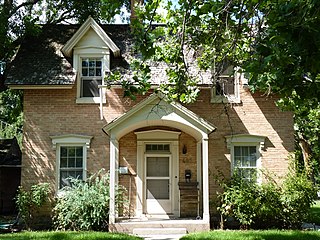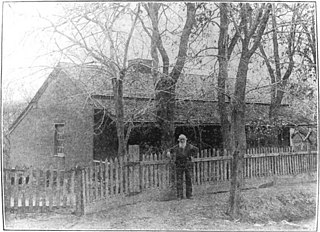
The Arnold Homestead is a historic homestead in the city of Huber Heights, a suburb of Dayton, Ohio, United States. Formed at the turn of the nineteenth century, it centers on an 1830s farmhouse that was built for an immigrant family from Virginia.
Heritage Hill State Historical Park, is a 56-acre open-air museum located in Allouez, Wisconsin near Green Bay, Wisconsin, in the United States. A Wisconsin state park, the site is operated by a non-profit organization called the Heritage Hill Corporation in partnership with the Wisconsin Department of Natural Resources (DNR). The Heritage Hill Corporation operates, maintains and develops the park under terms of a lease with the DNR.

The Henry J. Wheeler Farm is a farmstead in Murray, Utah, United States, that is one of the few remaining late 19th century farmsteads in the Salt Lake Valley that has not been lost to expanding housing developments of metropolitan Salt Lake City. It has been listed on the National Register of Historic Places since 1976.

Stephenson–Campbell House, also known as the Stephenson–Campbell Property and the Stephenson Log House, is a historic site in Cecil, Pennsylvania containing four contributing buildings. Included are a 1778 log house, a 1929 Sears and Roebuck Company mail order bungalow style house, a 1929 spring house, and a 1928 garage. The log house is 16 feet by 34 feet, with several additions totaling about 1360 square feet. The log house is one of the few pre-1780 log houses still standing in Western Pennsylvania, and the only known example of a single story private home still extant in the area.
The Cedar City Historic District is a set of one hundred and seventy-two buildings in Cedar City, Utah. Of these, one hundred and four contribute to its historical integrity. Cedar City was originally an iron works near the Latter-day Saint city of Parowan. After Brigham Young shut down the iron facilities, two-thirds of Cedar City's residents left for other settlements. The remaining families prospered from sheep ranching. The Union Pacific Railroad connected to the town in the early 1900s and provided a tourism boom for the city. The district represents some of the oldest houses for Cedar City residents, most of which were farmers or ranchers. Later houses in the district represent early 20th century revivals.

The Johnson–Hansen House is a historic house located in Provo, Utah, United States, that is listed on the National Register of Historic Places.

The Parowan Meetinghouse, sometimes referred to as the Parowan Tabernacle or the Parowan Old Rock Church is a historic meetinghouse of the Church of Jesus Christ of Latter-day Saints in Parowan, Utah, United States, that is listed on the National Register of Historic Places (NRHP).
The Davis–Ercanbrack Farmstead was a farmstead on the southern edge of Orem, Utah, United States, that was previously listed on the National Register of Historic Places (NRHP).

Priddy Meeks was an American frontier doctor who practiced Thomsonian medicine. He was a polygamist member of the Church of Jesus Christ of Latter-day Saints and helped settle areas in Utah as a Mormon pioneer. Meeks was the first doctor in Southern Utah. He occasionally appears as a character in Mormon literature, such as the short story "They Did Go Forth" by Maurine Whipple.

The McPolin Farmstead is a historic farm north of Park City, Utah, United States. It has buildings constructed c. 1921 and later, including a large "improvement era" dairy barn, approximately 100 by 35 feet in footprint. It was purchased by, and is owned by, the nearby city of Park City, Utah. It was listed on the National Register of Historic Places in 2003.

The Stewart–Hills House is a historic house located at 275 East 2000 South in Orem, Utah was built in 1915.

The Benjamin and Olivia Meek House is a historic house located at 12782 South Fort Street in Draper, Utah.

The Gridley–Howe–Faden–Atkins Farmstead, also known as Brookside Farm, in Kimball County, Nebraska near Kimball, is a historic, well preserved farmstead. It has buildings and structures dating from 1899 when Henry H. Howe built a 38-by-38-foot one-story limestone house until 1947 when the last structure on the property was built. The property claim had been proven by James Gridley in 1891, at which time the property was irrigated, but Gridley moved on to Utah, and Howe obtained the farm.
The William and Amanda J. Ellis Farmstead Historic District is a nationally recognized historic district located near Elliott, Iowa, United States. It was listed on the National Register of Historic Places in 2015. At the time of its nomination it contained four resources, which included two contributing buildings, and two non-contributing buildings. William and Amanda Jane Ellis owned this farm from 1882 to 1919. During that time the Queen Anne style house with Stick influences and the heavy timber frame barn were built. Both were constructed around 1900. Two garages are the non-contributing buildings.

The John and Marie (Palen) Schrup Farmstead Historic District is a nationally recognized historic district in Dubuque County, Iowa, United States. It was listed on the National Register of Historic Places in 2009. At the time of its nomination it consisted of four resources, which included three contributing buildings and one non-contributing building. The three buildings include a stone house, barn, and well-house. The buildings are typical of those constructed by immigrant families from Luxembourg that settled in Dubuque and nearby Jackson counties. The front part of the house is the oldest structure here and was built when Martin Burkhart owned the property. He sold the farmstead to Casper Burkhart the following year, who then sold it to John and Marie Schrup in 1856. The Schrups were responsible for adding onto the back of the house about the time they bought it and the other two buildings. The dairy farm of 193 acres (78 ha) remained in the family until 1973. Because it was always a modest enterprise, the stone buildings were not torn down and replaced with modern structures as happened on many of the Luxembourgian farms built in the mid-19th century. A wooden shed was built in the early 20th century, and is the non-contributing building. A pole barn was also added to the farmstead and it fell down c. 1995.

The William and Julia Lyman House in Parowan, Utah was constructed in c. 1895. Constructed by William and Julia Lyman, the house is common for an eighteenth-century American building construction. It is one of the few remaining houses of its kind in Parowan.

The Jesse N. Smith House, located in Parowan, Utah, is a two-story home that was constructed from June 1856 to March 1858. Jesse N. Smith was asked by church leadership to assist in the settling of Parowan in 1851, where he constructed and lived in the house. The house is constructed from quarried rock, baked adobe, and hewed timber. Originally consisting of four rooms - two upstairs and two downstairs - an addition was later added to the rear of the house that consisted of four additional rooms. It is the oldest adobe structure in the state of Utah.

The Jan F. and Antonie Janko Farmstead District is an agricultural historic district located west of Ely, Iowa, United States. It was listed on the National Register of Historic Places in 2000. At the time of its nomination it consisted of seven resources, which included five contributing buildings, one contributing structure, and one non-contributing structure. The historic buildings include a two-story, wood frame, side gable house (1887); a gabled basement barn ; a gabled barn (1893); chicken house, and a single-stall garage (1910s-1930s). The corncrib is the historic structure. A three-stall garage (1972) is the non-contributing structure. The farmstead is located on a hilltop and sideslope. The house sits on the highest elevation, with the outbuildings located down the slope to the west and southwest.

The John Steele House is the historic home of a prominent early resident of Toquerville, Utah. One of the Mormon pioneers, John Steele built the house in 1862 and lived there until his death in 1903, working as an herbal physician and serving in a number of town and county offices. Its floor plan is a rare double-parlor style.
The W.L. and Winnie (Woodfield) Belfrage Farmstead Historic District is a nationally recognized historic district located south of Sergeant Bluff, Iowa, United States. It was listed on the National Register of Historic Places in 2017. At the time of its nomination it contained six resources, which included four contributing buildings and two non-contributing buildings. The four contributing buildings are the dairy barn (1910), farmhouse (1920), brooder house, and the chicken coop. The two no-contributing buildings are the cattle shed (1960) and the garage/utility building (2006).

















